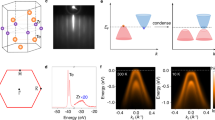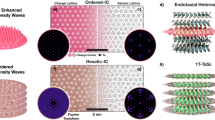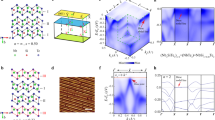Abstract
In solids, the condensation of electron and hole pairs with finite momentum leads to an ordered state known as a charge density wave, in which the charge has spatial modulation. However, lattice symmetry breaking and the accompanying relocation of the ions, which changes the charge distribution, can also occur simultaneously, making it difficult to disentangle the origin of the transition. Here we demonstrate a condensed phase in low-dimensional HfTe2. Angle-resolved photoemission spectroscopy measurements reveal a metal–insulator transition upon lowering the temperature. The observation of an opening gap, the renormalization of the bands and the emergence of replica bands in the low-temperature regime suggests that a charge density wave formed in the ground state. Raman spectroscopy shows no sign of lattice distortion within the detection limit. A small amount of electron doping substantially raises the transition temperature due to a reduced screening effect and a more balanced carrier density for electrons and holes. Our results indicate that the formation mechanism of the charge density wave is consistent with the excitonic insulator phase in low-dimensional HfTe2 without any structural modification.
This is a preview of subscription content, access via your institution
Access options
Access Nature and 54 other Nature Portfolio journals
Get Nature+, our best-value online-access subscription
$29.99 / 30 days
cancel any time
Subscribe to this journal
Receive 12 print issues and online access
$209.00 per year
only $17.42 per issue
Buy this article
- Purchase on Springer Link
- Instant access to full article PDF
Prices may be subject to local taxes which are calculated during checkout




Similar content being viewed by others
Data availability
Source data are provided with this paper. All other data that support the plots within this article and other findings of this study are available from the corresponding author upon reasonable request.
References
Grüner, G. The dynamics of charge-density waves. Rev. Mod. Phys. 60, 1129–1181 (1988).
Peierls, R. E. Quantum Theory of Solids (Oxford Univ. Press, 1955).
Mott, N. F. The transition to the metallic state. Philos. Mag. 6, 287–309 (1961).
Keldysh, L. V. & Kopaev, Y. V. Possible instability of semimetallic state toward Coulomb interaction. Sov. Phys. Solid State 6, 2219–2224 (1965).
Jérome, D., Rice, T. M. & Kohn, W. Excitonic insulator. Phys. Rev. 158, 462 (1967).
Kohn, W. Excitonic phases. Phys. Rev. Lett. 19, 439 (1967).
Halperin, B. I. & Rice, T. M. Possible anomalies at a semimetal–semiconductor transition. Rev. Mod. Phys. 40, 755–766 (1968).
Kogar, A. et al. Signatures of exciton condensation in a transition metal dichalcogenide. Science 358, 1314–1317 (2017).
Holt, M. et al. X-ray studies of phonon softening in TiSe2. Phys. Rev. Lett. 86, 3799–3802 (2001).
Wakisaka, Y. et al. Excitonic insulator state in Ta2NiSe5 probed by photoemission spectroscopy. Phys. Rev. Lett. 103, 026402 (2009).
Kim, K. et al. Direct observation of excitonic instability in Ta2NiSe5. Nat. Commun. 12, 1969 (2021).
Mazza, G. et al. Nature of symmetry breaking at the excitonic insulator transition: Ta2NiSe5. Phys. Rev. Lett. 124, 197601 (2020).
Windgätter, M. et al. Common microscopic origin of the phase transitions in Ta2NiS5 and the excitonic insulator candidate Ta2NiSe5. NPJ Comput. Mater. 7, 210 (2021).
Lu, H. et al. Evolution of the electronic structure in Ta2NiSe5 across the structural transition revealed by resonant inelastic X-ray scattering. Phys. Rev. B 103, 235159 (2021).
Gao, Q. et al. Evidence of high-temperature exciton condensation in a two-dimensional semimetal. Nat. Commun. 14, 994 (2023).
Varsano, D. et al. A monolayer transition-metal dichalcogenide as a topological excitonic insulator. Nat. Nanotechnol. 15, 367–372 (2020).
Ataei, S. S. et al. Evidence of ideal excitonic insulator in bulk MoS2 under pressure. Proc. Natl Acad. Sci. USA 118, 13 (2021).
Jia, Y. et al. Evidence for a monolayer excitonic insulator. Nat. Phys. 18, 87–93 (2022).
Sun, B. et al. Evidence for equilibrium exciton condensation in monolayer WTe2. Nat. Phys. 18, 94–99 (2022).
Chen, P. et al. Charge density wave transition in single-layer titanium diselenide. Nat. Commun. 6, 8943 (2015).
Nakata, Y. et al. Dimensionality reduction and band quantization induced by potassium intercalation in 1T-HfTe2. Phys. Rev. Mater. 3, 071001(R) (2019).
Klipstein, P. C. et al. Electronic properties of HfTe2. J. Phys. C: Solid State Phys. 19, 4953 (1986).
Aminalragia-Giamini, S. et al. Molecular beam epitaxy of thin HfTe2 semimetal films. 2D Mater. 4, 015001 (2016).
Zakariae, E. Y. et al. Bulk and surface electronic states in the dosed semimetallic HfTe2. Phys. Rev. B 101, 235431 (2020).
Eisenstein, J. P. & MacDonald, A. H. Bose–Einstein condensation of excitons in bilayer electron systems. Nature 432, 691–694 (2004).
Unuchek, D. et al. Room-temperature electrical control of exciton flux in a van der Waals heterostructure. Nature 560, 340–344 (2018).
Jauregui, L. A. et al. Electrical control of interlayer exciton dynamics in atomically thin heterostructures. Science 366, 870–875 (2019).
Wang, Z. et al. Evidence of high-temperature exciton condensation in two-dimensional atomic double layers. Nature 574, 76–80 (2019).
Ma, L. et al. Strongly correlated excitonic insulator in atomic double layers. Nature 598, 585–589 (2021).
Cruzado, H. N. et al. Band engineering and van Hove singularity on HfX2 thin films (X= S, Se, or Te). ACS Appl. Electron. Mater. 3, 1071–1079 (2021).
Tsipas, P. et al. Epitaxial HfTe2 Dirac semimetal in the 2D limit. APL Mater. 9, 101103 (2021).
Chen, P. et al. Dimensional effects on the charge density waves in ultrathin films of TiSe2. Nano Lett. 16, 6331–6336 (2016).
Masanori, H., Shin-Ichi, N. & Akiyoshi, M. Raman spectroscopic studies of MX2-type layered compounds. Ferroelectrics 52, 151–159 (1983).
Lin, D. et al. Patterns and driving forces of dimensionality-dependent charge density waves in 2H-type transition metal dichalcogenides. Nat. Commun. 11, 2406 (2020).
Duong, D. L. et al. Raman characterization of the charge density wave phase of 1T-TiSe2: from bulk to atomically thin layers. ACS Nano 11, 1034–1040 (2017).
Yang, H.-B. et al. Fermi surface evolution and Luttinger theorem in NaxCoO2: a systematic photoemission study. Phys. Rev. Lett. 95, 146401 (2005).
Norman, M. R. et al. Phenomenology of the low-energy spectral function in high-TC superconductors. Phys. Rev. B 57, R11093 (1998).
Chikina, A. et al. Turning charge-density waves into Cooper pairs. npj Quantum Mater. 5, 22 (2020).
Zong, A. Emergent States in Photoinduced Charge-Density-Wave Transitions (Springer, 2021); https://doi.org/10.1007/978-3-030-81751-0
Tallon, J. L. et al. Superfluid density in cuprate high-TC superconductors: a new paradigm. Phys. Rev. B 68, 180501 (2003).
Vishik, I. M. et al. Phase competition in trisected superconducting dome. Proc. Natl Acad. Sci. USA 109, 18332–18337 (2012).
Yang, Y. et al. High-resolution ARPES endstation for in situ electronic structure investigations at SSRF. Nucl. Sci. Tech. 32, 31 (2021).
Riley, J. M. et al. Negative electronic compressibility and tunable spin splitting in WSe2. Nat. Nano 10, 1043–1047 (2015).
Kresse, G. & Furthmüller, J. Efficiency of ab-initio total energy calculations for metals and semiconductors using a plane-wave basis set. Comput. Mater. Sci. 6, 15–50 (1996).
Kresse, G. & Furthmüller, J. Efficient iterative schemes for ab initio total-energy calculations using a plane-wave basis set. Phys. Rev. B 54, 11169–11186 (1996).
Blöchl, P. E. Projector augmented-wave method. Phys. Rev. B 50, 17953–17979 (1994).
Kresse, G. & Joubert, D. From ultrasoft pseudopotentials to the projector augmented-wave method. Phys. Rev. B 59, 1758–1775 (1999).
Perdew, J. P., Burke, K. & Ernzerhof, M. Generalized gradient approximation made simple. Phys. Rev. Lett. 77, 3865–3868 (1996).
Grimme, S. et al. A consistent and accurate ab initio parametrization of density functional dispersion correction (DFT-D) for the 94 elements H–Pu. J. Chem. Phys. 132, 154104 (2010).
Togo, A. & Tanaka, I. First principles phonon calculations in materials science. Scr. Mater. 108, 1–5 (2015).
Gresch, D. et al. Z2Pack: numerical implementation of hybrid Wannier centers for identifying topological materials. Phys. Rev. B 95, 075146 (2017).
Soluyanov, A. A. & Vanderbilt, D. Computing topological invariants without inversion symmetry. Phys. Rev. B 83, 235401 (2011).
Tang, F. et al. Comprehensive search for topological materials using symmetry indicators. Nature 566, 486–489 (2019).
Acknowledgements
We thank T. C. Chiang, W. Ku and X. Xu for helpful discussions. The work at Shanghai Jiao Tong University is supported by the Ministry of Science and Technology of China (grant nos. 2021YFE0194100 to P.C., 2022YFA1402400 to P.C., 2021YFA1401400 to S.W.J. and 2021YFA1400100 to S.W.J.), the Science and Technology Commission of Shanghai Municipality (grant no. 21JC1403000 to P. C.), the National Natural Science Foundation of China (grant nos. 12174250 and 12141404 to S.W.J.), the Shanghai Jiao Tong University 2030 Initiative and the Yangyang Development Fund. Y.H.C. acknowledges support from the Ministry of Science and Technology, National Center for Theoretical Sciences (grant no. 110-2124-M-002-012) and the National Center for High‑performance Computing in Taiwan. Part of this research is supported by the ME2 project under Contract No. 11227902 from the National Natural Science Foundation of China.
Author information
Authors and Affiliations
Contributions
P.C. conceived the project. Q.G. and P.C. with the aid of H.Y.C., Y.C.Y, Z.T.L. and D.W.S. performed the MBE growth, ARPES measurements and data analysis. Y.H.C. and K.T. performed the calculations. P.F.J. and S.W.J. performed the Raman measurements. P.C., Q.G., H.Y.C., S.S.Y. and X.L.L. carried out the X-ray diffraction measurements. P.C., Y.H.C. and Q.G. interpreted the results. P.C. wrote the paper with input from the other co-authors.
Corresponding author
Ethics declarations
Competing interests
The authors declare no competing interests.
Peer review
Peer review information
Nature Physics thanks Simone Latini and the other, anonymous, reviewer(s) for their contribution to the peer review of this work.
Additional information
Publisher’s note Springer Nature remains neutral with regard to jurisdictional claims in published maps and institutional affiliations.
Extended data
Extended Data Fig. 1 Core-level scans and RHEED patterns on HfTe2 Films.
(a) Core-level photoemission spectra taken with 90 eV photons for a 1 TL HfTe2/BLG/SiC film. (b) An example of RHEED intensity oscillations of the central diffraction spot as a function of time. (c) A RHEED pattern of single-layer HfTe2 film taken at room temperature. (d) RHEED patterns as a function of the HfTe2 thickness, indicating similar in-plane lattice constants in single-layer and multilayer films.
Extended Data Fig. 2 Photon energy dependence of the ARPES spectra for 1 TL HfTe2.
(a)-(e) ARPES maps taken with various photon energies along \(\overline{\Gamma {\rm{M}}}\) for 1 TL HfTe2/BLG/SiC (n − p = −5.4 ×1012/cm2) at 10 K. (f) Calculated unfolded band structure for a (2 × 2) superstructure using the PBE method with a imposed Hf displacement of 1.3% of the lattice constant. (g) Relative intensity ratio of the lower folded valence band (at ~−0.5 eV) to the upper folded band with background subtracted. Regions of interest used for integrating the folded band intensity were indicated as red boxes shown in panel (a). To reduce the matrix element effect, we extract the relative folded band intensities (If) with respect to the main band intensities (Im). The DFT calculated ratio results with a series of imposed lattice distortions are shown as a solid line. The smallest imposed lattice distortion is 0.33% of the lattice constant since the calculated two folded bands are indistinguishable in energy below this value. It is clear that the experimental results with different photon energies are well below the smallest predicted value, resulting in an upper bound for the magnitude of the lattice distortion ( ~ 0.013 Å) in 1 TL HfTe2.
Extended Data Fig. 3 More thickness dependent band structures of low dimensional HfTe2.
ARPES maps along \(\overline{\Gamma {\rm{M}}}\) for low dimensional HfTe2 at (a) 250 K and (b) 10 K. (c) Corresponding symmetrized ARPES maps in energy about the Fermi level at 10 K. The decimals in the layer thickness are nominal and determined from the relative intensity of the subbands in the adjacent layers.
Extended Data Fig. 4 Raman scattering spectra of single layer HfTe2 films.
Temperature-dependent Raman scattering spectra for 1 TL HfTe2 on (a) HOPG and (d) bilayer-graphene-terminated SiC. (b), (e) zoom-in of the Raman spectra in a region below 3 THz. No new peaks were observed across the measured temperature range that could indicate any structural distortion. (c), (f) Corresponding extracted Raman frequencies of the E and A1 modes between 2.8 and 4.3 THz as a function of temperature.
Extended Data Fig. 5 DFT band dispersions and phonon results of N-layer HfTe2 (N = 1–3).
(a) Calculated band structures in the normal phase for N-layer HfTe2. (b) Enlarged plots to show details around the zone center. The band characters, Hf 5d or Te 5p, are color coded. (c) Phonon dispersions for N-layer HfTe2 in the normal phase computed from first principles.
Extended Data Fig. 6 Calculated band structure and phonon dispersions with PBE + U = 7 eV.
Hubbard U is included to account for the electron localization and (a) the band structure agrees well with the experiments. (b) The calculated phonon dispersions with U also shows no imaginary frequencies, predicting no structural instability.
Extended Data Fig. 7 Temperature dependence of the band structure of single-layer HfTe2.
ARPES maps on 1 TL HfTe2/BLG/SiC (n − p = −5.4 × 1012/cm2) taken with (a) 45 and (b) 60 eV photons along the \(\overline{\Gamma {\rm{M}}}\) direction at selected temperatures.
Extended Data Fig. 8 Temperature dependence of the band structure and the energy gaps for 1 TL HfTe2 with different doping levels.
(a) EDCs at the zone center at selected temperatures between 10 and 250 K. (b) Corresponding symmetrized EDCs. The temperature dependence of the Fermi-Dirac distribution can be canceled out by symmetrization. The fits to a phenomenological BCS-type function are indicated as solid curves. (c) EDCs at the \(\bar{{\rm{M}}}\) point at selected temperatures between 10 and 250 K. (d) The extracted temperature dependence of the square of the energy gap. The red curves are fitting results using the BCS-type mean-field equation.
Extended Data Fig. 9 Topological Z2 invariant calculations.
Evolution of HWCC (black empty dots) and the middle of the larges gap (blue triangles) along the \(\overline{\Gamma {\rm{M}}}\) direction for (a) 2 TL and (b) 3 TL HfTe2. (c) and (d) are the corresponding zoom-in details near the \(\overline{\Gamma \,}\) point.
Extended Data Fig. 10 Carrier density estimation for the conduction band tail.
(a) A schematic diagram of the conduction band spectral function. The magenta solid line indicates the center of mass of the conduction band and the magenta dashed lines demonstrate the broadened spectral function. The cyan dots represent the peak position of the MDC fitting results used to calculate the carrier density, which actually means the carrier density at the position as if the Fermi level is at the green dashed line. (b) Schematic of the EDC along the cut through one of the cyan dots. The green line is the conduction band peak at this position. As a simple approximation, the ratio of the shadow area to that of the green line represents the ratio of the carrier density at Fermi level (EF) to that at the position marked by the green line. Since the carrier density at the green line position was obtained by formula \(N={{\rm{g}}}_{v}\frac{{k}_{F}^{2}}{2\pi }\), we can thus estimate the carrier density at the Fermi level (EF). (c) An example fit for the highest electron doping case. The black curve is the fitting result which is a combination of the Shirley background, the Lorentzian peak multiplied by the Fermi-Dirac function and convoluted with a Gaussian corresponding to the experimental energy resolution.
Source data
Source Data for Fig. 1
Raw data for Fig. 1.
Source Data for Fig. 3
Raw data for Fig. 3.
Source Data for Fig. 4
Raw data for Fig. 4.
Rights and permissions
Springer Nature or its licensor (e.g. a society or other partner) holds exclusive rights to this article under a publishing agreement with the author(s) or other rightsholder(s); author self-archiving of the accepted manuscript version of this article is solely governed by the terms of such publishing agreement and applicable law.
About this article
Cite this article
Gao, Q., Chan, Yh., Jiao, P. et al. Observation of possible excitonic charge density waves and metal–insulator transitions in atomically thin semimetals. Nat. Phys. 20, 597–602 (2024). https://doi.org/10.1038/s41567-023-02349-0
Received:
Accepted:
Published:
Issue Date:
DOI: https://doi.org/10.1038/s41567-023-02349-0



